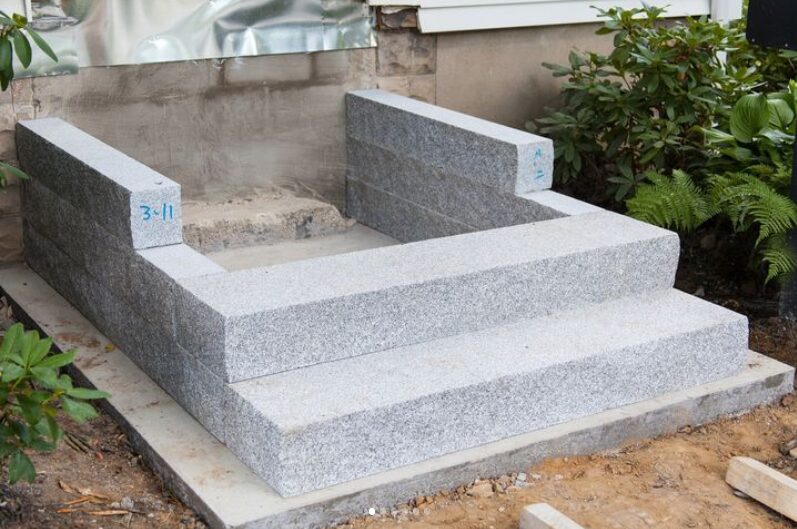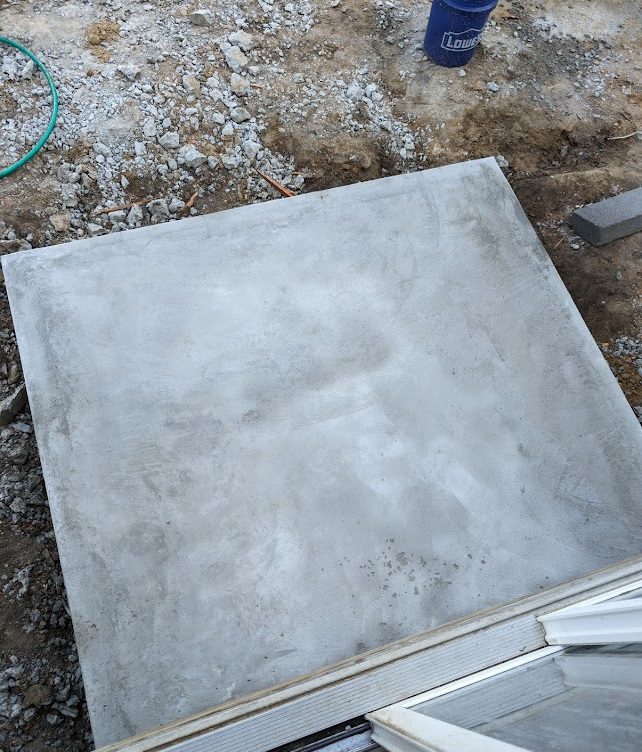The longevity and stability of your granite steps hinge on one critical factor that often goes unseen: the base upon which they rest. A properly prepared base is not just a foundation; it’s the unsung hero that protects your investment, ensures safety and maintains the beauty of your home’s entrance for decades to come. In the harsh and varied climate of Maine, where freeze-thaw cycles and heavy snow loads are the norm, the importance of a well-constructed base cannot be overstated.
At Stone Solutions Maine, we’ve spent over three decades perfecting the art and science of granite step installation. Our experience, spanning thousands of projects across the diverse landscapes of our state, has consistently reinforced one fundamental truth: the quality of what lies beneath the steps is just as crucial as the granite itself.
This guide will delve into the critical aspect of base preparation for granite steps. Drawing from our 30 years of expertise, we’ll explain why proper base preparation is essential for the longevity and stability of your granite steps, especially in Maine’s challenging climate.
Whether you’re planning to renovate your home’s entrance or construct a new one, understanding the importance of a well-prepared base is vital. This knowledge will empower you to make informed decisions about your project, whether you choose to tackle it yourself or work with professionals.

Photo Credit: Swenson Stone Works
Why Base Preparation Matters
The climate in Maine presents unique challenges for outdoor structures. Frequent freeze-thaw cycles and heavy snow loads typical of our winters can cause significant damage to improperly installed steps. A meticulously prepared base does more than just provide a stable foundation; it’s a crucial factor in preventing settling, shifting, and potential safety hazards that can develop over time.
Assessing Your Site
Before we dive into the nitty-gritty of base preparation, it’s essential to assess your site’s conditions. Here in Maine, we deal with a variety of soil types, from rocky to clay-heavy. Each presents its own set of challenges.
- Soil Survey: Take time to check the condition and quality of your soil. This step is crucial and often overlooked. The existing soil conditions will dictate how deep you need to excavate and what kind of reinforcement might be necessary.
- Step Size Consideration: The size and weight of your granite steps also play a role in base preparation. Larger, heavier sets of steps require more extensive prep work to ensure long-term stability.
- Drainage Assessment: Given our wet springs and snowy winters, proper drainage is critical. You need to ensure water doesn’t pool around your steps, which could lead to erosion or frost heaves.

Choosing Your Base: Concrete vs. Gravel
While there are both concrete and gravel options for your granite step base, we often recommend a concrete pad for its superior stability and longevity. Here’s why concrete is often the preferred choice and how to implement it:
Benefits of a Concrete Pad
- Superior Stability: Concrete provides a solid, immovable foundation that resists settling and shifting over time.
- Longevity: A well-constructed concrete base can last for decades with minimal maintenance.
- Versatility: Suitable for any size project, from small entryways to large, multi-step installations.
- Uniform Support: Ensures even weight distribution, preventing stress points on your granite steps.
Installing a Concrete Pad
- Excavation: Dig out an area approximately 6 inches deep, extending 2 inches beyond the step dimensions on all sides.
- Forming: Construct a form using 2×6 boards, ensuring it’s perfectly level in all directions.
- Reinforcement: Consider adding rebar or wire mesh for additional strength, especially for larger installations.
- Concrete Pouring: Use Ready Mix concrete, carefully filling the form and screeding off the excess for a smooth surface.
- Curing: Allow the concrete to cure for about a week, depending on weather conditions, before installing the steps.
When to Consider Gravel
While concrete is often ideal, a compacted gravel pad might be suitable in certain situations:
- For small, lightweight installations
- In areas where exceptional drainage is required
- When a more flexible base is needed due to specific site conditions
However, even in these cases, a concrete pad with proper drainage considerations often provides a superior long-term solution.
Installing a Gravel Pad
Here’s how to approach a gravel pad installation:
- Excavation: Start by digging out an area about 1 foot deep. The width should extend about 6 inches beyond the outer dimensions of your steps on each side.
- Material Selection: Use processed gravel, also known as driveway base or crushed bank run. This material contains a mix of crushed stone, sand, and fines that compact exceptionally well.
- Layering and Compaction: Add the gravel in 3-4 inch layers, compacting each layer thoroughly before adding the next. This gradual build-up ensures a solid, stable base.
- Compaction Equipment: For best results, use a gas-operated plate compactor. You can rent one from most equipment rental stores.
- Leveling: Carefully level the final layer both left to right and front to back. This step is crucial for ensuring your granite steps sit perfectly level.
The Ultimate Base: Combining Gravel and Concrete
For the absolute best results, especially for larger step sets or in areas with poor soil conditions, we recommend a combination approach:
- Start with a properly prepared and compacted gravel base (as described above).
- Pour a 6-inch thick concrete pad on top of the gravel base.
This method provides the drainage benefits of gravel with the solid, level surface of concrete, making step installation easier and providing maximum long-term stability.
Additional Reinforcement Techniques
In some cases, particularly in areas with poor soil conditions or for very large step sets, you might want to consider additional reinforcement techniques:
- Geosynthetic Fabric: This material helps prevent settlement and provides additional stability. Consider layering it between gravel layers for added reinforcement.
- Deeper Excavation: In areas with particularly poor soil, you might need to excavate deeper (up to 2 feet) to ensure a stable base.
- Frost Protection: In areas prone to severe frost heaves, consider incorporating insulation or adjusting the depth of the base to extend below the frost line.
Calculating Materials
To help you plan your project, here’s a simple formula for calculating the amount of material you’ll need:
- Measure the length and width of your planned pad area.
- Multiply length x width x depth (in inches).
- Divide the result by 144 to get the volume in cubic feet.
For example, for a pad measuring 48″ x 36″ x 6″: (48″ x 36″ x 6″) / 144 = 72 cubic feet
Professional Installation vs. DIY
While it’s possible to prepare a base for granite steps as a DIY project, it’s a task that requires careful planning, the right equipment, and a good deal of physical labor. Here at Stone Solutions Maine, we have the experience and equipment to ensure your base is prepared correctly, taking into account Maine’s unique climate and soil conditions.
If you do decide to tackle this as a DIY project, don’t hesitate to reach out to us for advice. We’re always happy to provide guidance to ensure your project’s success.
Preparing a proper base for your granite steps is an investment in the long-term beauty and functionality of your home’s entrance. While it might seem like a lot of work upfront, a well-prepared base will save you from potential headaches and costly repairs down the road.
Remember, your granite steps are more than just an entrance to your home – they’re a statement piece that adds value and curb appeal. By ensuring they have a solid foundation, you’re protecting your investment and creating a safe, beautiful entrance that will last for generations.
We’re committed to helping you create the perfect entrance for your home. Whether you need advice on base preparation, help choosing the right granite steps, or full installation services, we’re here to help. If you find yourself unsure at any point during your DIY project, don’t hesitate to reach out to us for guidance. Contact us to discuss your project – we’d love to help you create an entrance that’s as solid and enduring as Maine itself.

